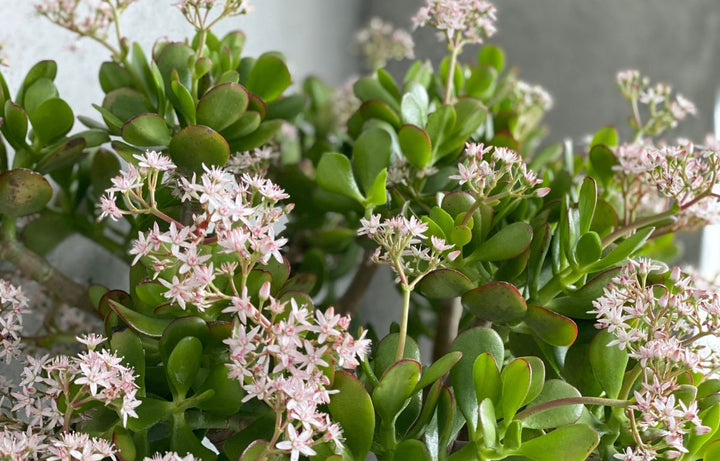
Popular Indoor Plants That You May Not Know Flower
Popular Indoor Plants That You May Not Know Flower
Did you know that many of your favourite indoor plants such as the Snake Plant and Philodendrons are flowering plants? If the answer is no, then you are certainly not alone!
When it comes to flowering, these notoriously hardy and low-maintenance greens often become fussy and temperamental, requiring very specific sunlight, soil, and watering combinations that are incredibly difficult to get just right.
Many of us are happy just to see a new leaf unfurl, but for those of us willing to take on the challenge and coax these elusive blooms into existence, here are some tips and tricks to help your favourite indoor plants flower, and gain well-earned bragging rights in the process.

Hoya Carnosa Apocynaceae
Clustering magenta-centred white corona star-shaped flowers.
- Hoyas will only flower once they reach a maturity of around 3 years of age.
- Specifically for this plant, stress is what triggers the production of flowers and pollen to reproduce.
- The easiest way to induce stress is by allowing the roots to become slightly pot-bound.
- Contrary to most other indoor plants, being pot-bound will not harm your Hoya as it is an extremely slow-growing plant.
- When you do re-plant your Hoya into a new pot it must only be slightly larger than the previous one. The plant can go into shock if there is too much space.
- If your Hoya does produce flowers, they will likely bloom anytime between Spring to Autumn or when ambient temperatures start to heat up above 18C.
- As a tropical plant, they prefer bright indirect sunlight with a high humidity concentration of around 60%.
- Although Hoyas prefer tightly packed potting soil the consistency should be moderately moist that is neither too wet nor too dry.
- Fertilise your plant every 3 weeks or so to promote abundant and healthy growth during spring and summer.
- After flowering be mindful that you do not remove the dead flowers from the stems even if they look scraggly. They will naturally fall off by themselves and you may risk removing the peduncles or stalks which produce the flowering buds. New flowers will only ever re-bud from these existing peduncles.
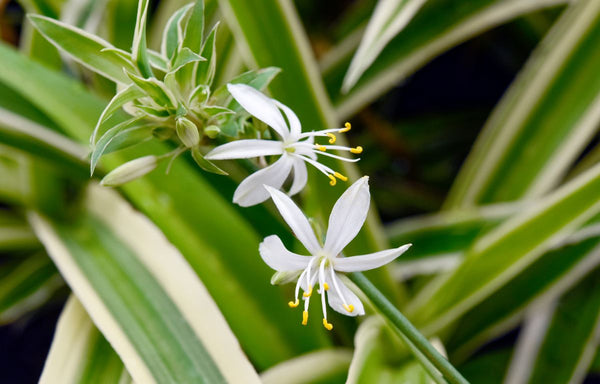
Spider Plant Chlorophytum comosum
Long spindly stems that produce tiny white flowers.
- Must be at least 2 years of age to be mature enough to produce flowers. Although Spider Plants have a lifespan of around twenty years. They will stop flowering once the plant becomes too old.
- Flowers will only form in warmer seasons and for a very short period each time.
- To promote flowering, Spider Plants prefer long periods of darkness (around 14 hours) followed by short bursts of bright indirect sunlight (around 6 hours).
- Like with the Hoya, Spider Plants like being slightly pot-bound which promotes flowering for reproduction.
- In addition to keeping your plant pot bound, decrease the amount of fertilisation during the growing period to induce more stress.
- Spider Plants are native to the tropical regions of Africa. They love a highly humid environment with a percentage of around 60% with consistently warm temperatures of 28-31C.
- After flowering, the buds will die back and new stems called spiderettes will grow in their place. These are ideal cutting for propagation.
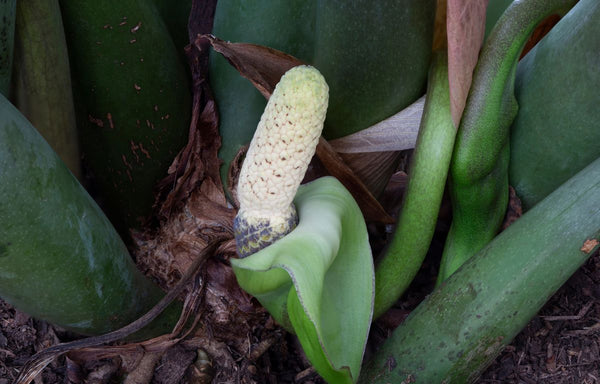
ZZ Plant Zamioculcas Zamiifolia
Thick cream-coloured spathe flowers that grow at the base of the plant.
- ZZ Plants must be at least 5 years of age before it is mature enough to produce flowers.
- They flower very rarely and when they do, the flowers can often be disguised by the foliage or mistaken for upward-growing roots.
- The flower is a tubular growth known as a cob. The cob encloses both male and female pollen but is not self-pollinating.
- ZZ Plants flower very rarely if ever when grown indoors and are only ever found on plants that are regularly exposed to natural changes in climate and weather conditions.
- The best way of exposing your plant to these conditions is by positioning it near windows that can be opened during warmer seasons to allow natural airflow. It is also safe to leave your plant outdoors for long periods of time.
- To encourage flowering, ZZ Plants need bright diffused and consistent sunlight.
- ZZ Plants originate from the hot and dry African Grasslands, so ideal temperatures need to be between 20-30C but with humidity levels being no higher than 30%.
- ZZ Plants hate tight soil, so make sure the potting mix is not heavily compacted and the roots are adequately aerated.
- Fertilisation during the warmer months should be increased to around twice a week to boost nutrients in the soil for an increase in energy production.
- Always check the soil before watering. It should feel completely dry to the touch. Thoroughly soak the soil when you do water your plant, allowing for the excess water to freely drain away from the pot.
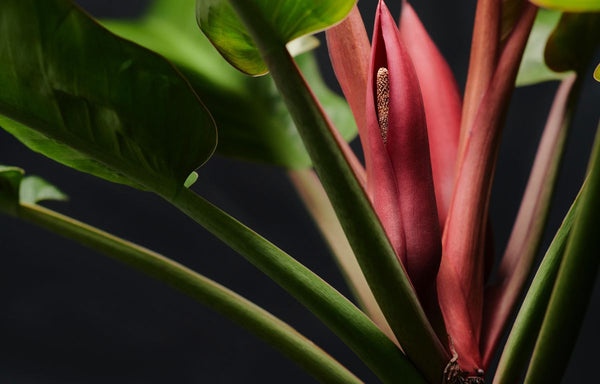
Philodendron
White or cream spadix flowers and depending on the variety, will have white, green, or even red-coloured spathes.
- As an original novice-safe indoor plant, Philodendrons are very hardy and very tolerant to a few learning mistakes and blunders. Having said that even the more experienced of us will struggle to encourage our Philodendron Plants to flower if they don’t feel like it. Persistence and patience are vital if you ever want to see flowers.
- Like with the other flowering indoor plants, buds will only occur once the plant reaches maturity and in the Philodendron’s case, can be anywhere between 10-15 years of age.
- Once they reach maturity, Philodendron Plants will only produce 1-3 flowers per year and will have a short flowering lifespan of around 2 days before dying back.
- If you are lucky and your plant does flower, you may find that they give off a strong earthy fragrance at nighttime.
- Although Philodendrons are notoriously for withstand both cool and warm temperatures alike, they are a tropical native of Central and South America. To flower, they require consistently high humidity levels of 60-70% with warm weather conditions of around 25C.
- They also love direct sunlight during the cooler seasons with dappled sunlight during the warm seasons.
- This plant does not like being pot-bound or restricted so make sure there is at least 5cm of space around the pot for the roots to stretch out and expand.
- It is recommended that you fertilise your plant every 4 weeks or so during the warm seasons but be careful to not over-fertilise as this will promote rapid foliage growth and prevent flowering.
- Flowering can take a lot of energy out of your Philodendron, so it is normal for your plant to turn dormant, slowing or stopping foliage growth until the next growing season.

Snake Plant Sansevieria
Tiny clustering white flowers that are grown from a central flower spike and give off a pleasant vanilla fragrance.
- Thought to be almost indestructible, Snake Plants are one of the most popular indoor plants for their low-light tolerance, and for their ability to filter pollutants and produce clean air.
- Ironically, caring for your Snake Plant and allowing it to thrive may be the reason why it will never produce flowers.
- Similar to Hoyas and Spider Plants, Snake Plants produce flowers when under stress in order to reproduce. The difference is that Snake Plants only do it when they are in severe distress and think they're about to die.
- As we can carefully monitor our indoor plants, flowering isn’t by any means the end of your Snake Plants as it would be in the wild. With continual care, your plants can stay healthy and hearty for up to their natural life span of around 25 years.
- Having said that, after flowering, Snake Plants are biologically unable to re-start new foliage growth so your plant will not become any larger than it already is unless it has previously formed new rhizomes that have not yet flowered.
- If your Snake Plant does flower, each rosette of leaves will produce a single flowering spike only once.
- The safest way to put stress on your plant and promote flowering without irrevocably harming it is by increasing the periods in between watering and allowing the roots to become slightly pot-bound.
- Although they are notoriously low-light tolerant, Snake Plants are native to West and West Central Africa and are made to take up as much sunlight as possible. High exposure will also increase the chances of flowering.
- For Snake Plants, natural ambient temperatures are not overly concerning when it comes to flowering just as long as it’s somewhat consistent. A moderate temperature of around 22C is fine, with an ideal humid level of 30-40% which is around the standard percentage for most Australian homes.
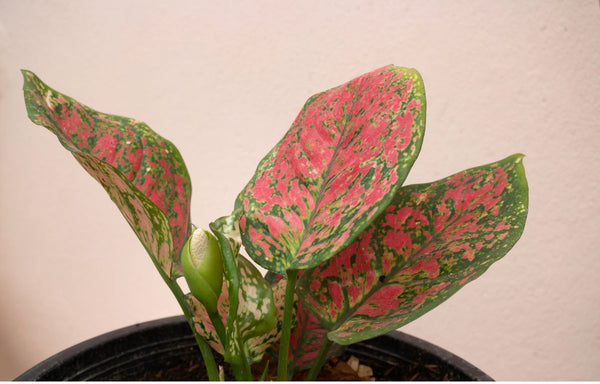
Chinese Evergreen Aglaonema
A relation of the Peace Lily, Aglaonemas produce a similar but smaller white or green spathe flower.
- Aglaonema Plants are so hardy they don’t even need soil to grow and can readily thrive in a vessel of water.
- However, flowering does require soil that has a high concentration of nitrogen and will only do so when the plant is at least 30 cm in growth or around 6 months old.
- Aglaonemas typically flower due to either exceptionally good care or neglect. However, the foliage is happy to thrive anywhere in between making it a top favourite for a low-maintenance indoor plant choice.
- When they do form, flowers are usually produced around late spring to early summer as sunlight is the brightest at that time of the year without being too hot, but they can occur anytime throughout the year depending on the conditions.
- Ordinarily Aglaonemas can withstand and even thrive in varying temperatures but to flower, they prefer warmer temperatures with moderate humidity like the Snake Plant. However, the soil should be constantly damp to the touch.
- Flowers generally go unnoticed as the buds are often mistaken for new furled leaves and only seem to live for a week or so before drying out.
- It requires too much energy for Aglaonemas to produce foliage and flowers at the same time. In order to flower, it will significantly slow down and even stop growing and producing new leaves altogether.
- Experienced gardeners generally recommend removing the buds as soon as they form unless they are wanting to intentionally stunt the plant’s growth. (See our blog Maintaining Your Plant for That Indoor Lifestyle).
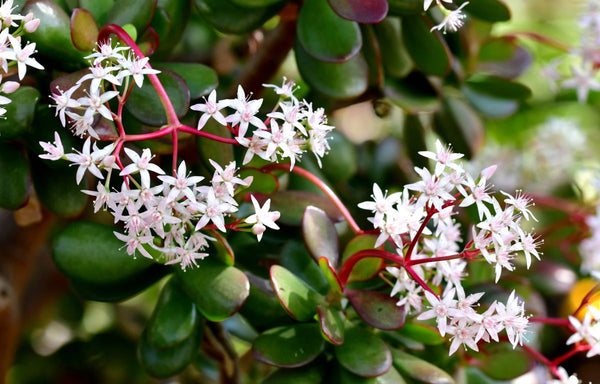
Jade Plant Crassula ovata
Small, white or soft pink coloured star-shaped flower that produces a slight floral-soapy smell.
- Flowering Jade Plants are symbolic of good friendship, luck, and prosperity.
- As with most of these plants, Jade Plants do need to reach a certain maturity to flower. Maturity is around 3-4 years of age or when it reaches around 1.5 meters in growth.
- They are hardy succulent plants that require very little attention to thrive and are one of the few plants that have the most flowering success when grown outdoors.
- Due to insulation, heating units and the natural vapour produced by our bodies, homes are usually perfect for foliage growth but are too humid for flowering, but it's certainly not impossible!
- Jade plants will only flower in dry winter and spring temperatures of around 10-20C with cool nights and short but bright sunny days. As their natural habitat is the hot and arid South African deserts, this ensures that their pollen can survive for reproduction and doesn't burn up in the scorching sun.
- Jade plants have a natural lifespan of 50-100 years of age and can flower sporadically throughout their entire life. They may even go through years of dormancy and suddenly produce buds with no rhyme or reason.
- Keep in mind that although they prefer cooler temperatures, Jade Plants store moisture in their leaves and can tear if the water is frozen and expands.
- Contrary to most green plants, during its growing period only water your Jade Plant sparingly and stop fertilising altogether. Before it starts budding, your plant will go through a quasi-dormant stage in which it conserves energy and requires less nutrients.
